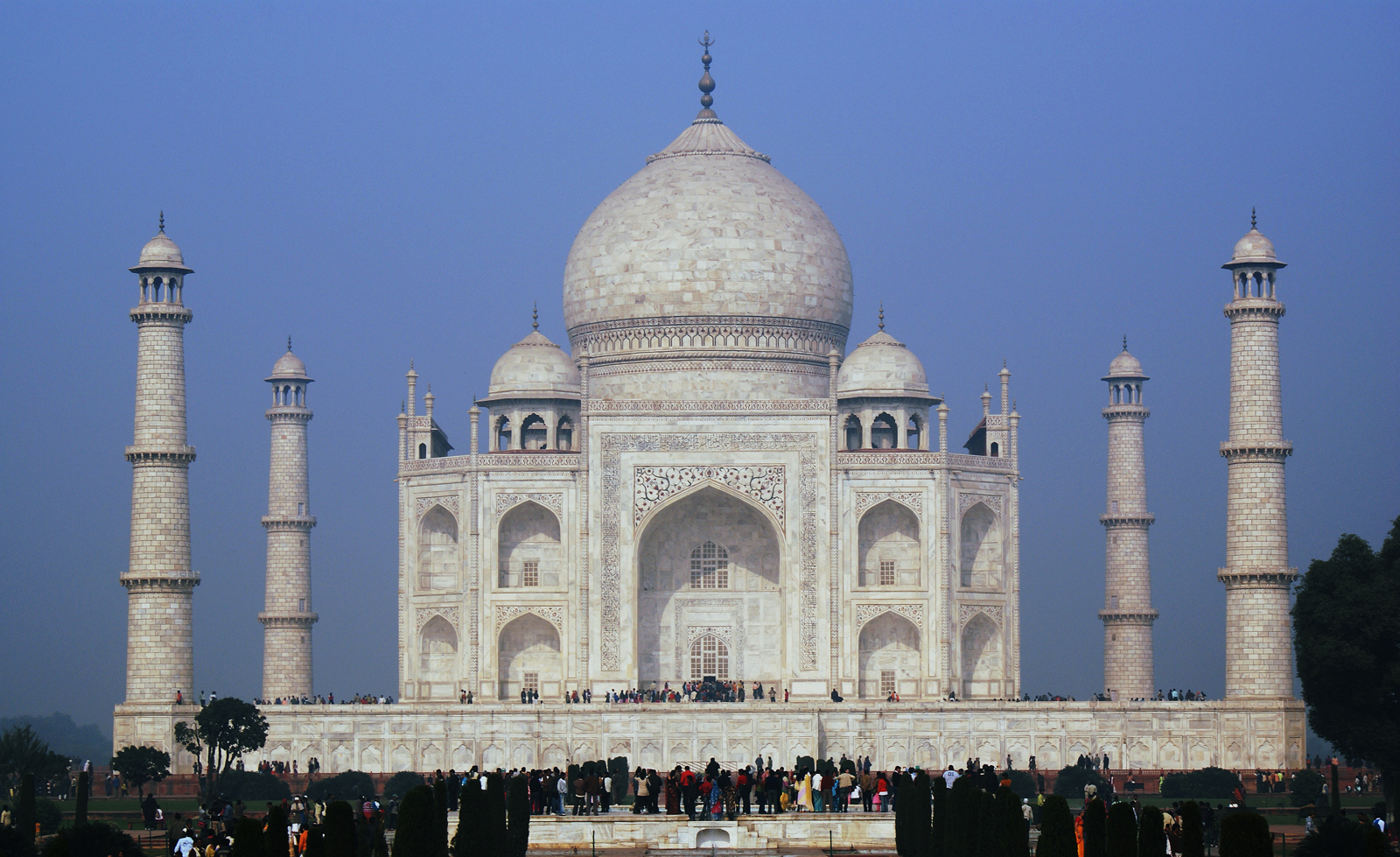Your 21-day South India adventure begins to unfold when you arrive in Chennai, the city formerly known as Madras on Friday 9 November and ends, after 3 glorious weeks of adventuring together, when you fly out of Kochi on Friday 30 November 2018.
Plan to fly into Chennai on Friday where you will be met and taken to your accommodation for the next couple of nights, and where you’ll meet your fellow travellers over dinner together.
Day 1: SATURDAY
Visit one of the world’s oldest motorcycle manufacturers still in business, Royal Enfield. First built in Great Britain, the Bullet 350 has been handcrafted the old-fashioned way at this factory since 1955 and is the longest running motorcycle model in continuous production. (The factory is rarely open to visitors!)
LUNCH at Hotel Saravana Bhavan, a long-running international chain serving up South Indian vegetarian dishes, including dosas. Yum!
As we explore Chennai, you’ll see reminders of British rule in India:
Fort St George
Built by the East India Company in 1644, Fort St George) is the first British fortress built in India by the East India Company. The construction of the fort provided the impetus for further settlements and trading activity, when South India was mostly an uninhabited land.
Namakkal Kavingyar Maaligai is a 10-storey building housing the Tamil Nadu Legislative Assembly, along with offices of the secretaries and departments. Between 2012 and 2014, the building was renovated at a cost of ₹ 28 crore (NZ$6 million.)
The Fort Museum was completed in 1795, first housed the Madras Bank and exhibits many relics that are reminders of British rule in India. The canons of Tipu Sultan decorate the ramparts of the museum.
A 14.5 ft statue stands inside the entrance, carved with a scene depicting Tipu Sultan’s emissary handing over Tipu’s two sons as hostages, in lieu of a ransom he was unable to pay to the British.
The flag staff at the fort is perhaps the tallest in the country. Made of teak wood, it is 150 feet (46 m) high.
St. Mary’s 17th-century church was built between 1678 and 1680 and is the oldest Anglican Church in India, with the oldest British tombstones dating back to that period. It is popularly referred to as the “Westminster Abbey of the East”.
Government Museum (beside Government Maternity Hospital, Pantheon Road, Egmore) The Government Museum or Madras Museum is a museum of human history and culture. Started in 1851, it is the second oldest museum in India after the Indian Museum in Kolkata.
Of course we’ll make time for some shopping:
- Pondy Bazaar a famous shopping centre – 3 stories of numerous shops for all seasons & all occasions from cheap to high price depending upon their quality.
- Express Avenue a modern shopping mall for big brands, cinema & restaurants
- Cottage Industries Exposition
Day 2: SUNDAY to Pondicherry
We visit the Dakshinachitra Traditional House. Inaugurated in 1996, this is an open-air, real-time museum as well as a cultural centre for craft communities in the South. You’ll see the ancient traditions of architecture, craftsmanship, performing arts and cuisine of Andhra Pradesh, Karnataka, Kerala and Tamil Nadu.
LUNCH: order a Thali or dosa and pooris at Dakshinachitra’s South Indian restaurant “Bekal”
This afternoon we visit Mahabalipuram, once the capital and a trading port on Bay of Bengal. You’ll see UNESCO World Heritage listed monuments built by the Pallava dynasty in the 7th and 8th centuries. The structures here, mostly carved in granite, are among the oldest existing examples of Dravidian (South Indian) architecture.
We reach Pondicherry which was the capital of India’s French colonies in the 17th century. You’ll notice plenty of French influences mixing with the local Tamil style in the city’s architecture.
We’ll stay in delightful accommodation beside the sea, where you can enjoy a beachside promenade.
Day 3: MONDAY Pondicherry
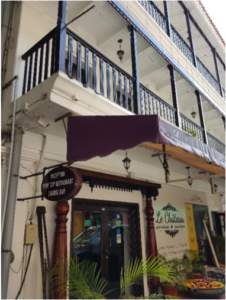 As a one time French settlement, Pondicherry is the perfect place to sample the local coffee, stroll the streets and enjoy an atmosphere best described as ‘east meets west.’
As a one time French settlement, Pondicherry is the perfect place to sample the local coffee, stroll the streets and enjoy an atmosphere best described as ‘east meets west.’
In fact, there’s so much to see, we’ll provide you with a map and turn you loose to enjoy the local atmosphere. We recommend you explore:
- The seafront Promenade, one of the liveliest areas in Pondicherry
- Gandhi Mandappam, the largest statue of Gandhi in Asia.
- The Botanical Gardens, in the French Quarter, established in 1826
- Pondicherry Museum – featuring an outstanding collection and a sculpture gallery
- Aurobindu Ashram – a synthesis of yoga and modern science
- Elegance – a very good jewellery and gift shop (run by friends of Rachel)
DINNER: Le Château bar & rooftop restaurant
Day 4: TUESDAY to Thanjavur
Thanjavur District, the Rice Bowl of Tamil Nadu, was the cultural capital of the country in 1790. Thanjavur has a painting style unique to the region.
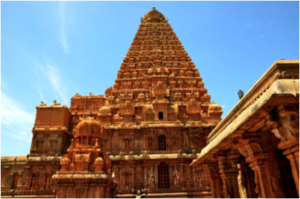 The Brihadeeswarar temple, along with Airavatesvara temple and Gangaikonda Cholapuram, is known as the ‘Great Living Chola Temple’ and is part of the UNESCO World Heritage Sites.
The Brihadeeswarar temple, along with Airavatesvara temple and Gangaikonda Cholapuram, is known as the ‘Great Living Chola Temple’ and is part of the UNESCO World Heritage Sites.
Also known as Rajarajeswaram, Brihadishwara is among the largest temples in the country and is dedicated to Shiva. More than 1000 years old and built from 60,000 tons of granite, the temple has the world’s tallest vimanam (temple tower) and its Kumbam (the structure on the top) weighs approximately 80 tons. At the entrance is a huge statue of Nandi (sacred bull.) Carved from a single rock, it weighs around 20 tons.
Day 5: WEDNESDAY Thanjavur
This morning we’ll visit Thanjavur Maratha Palace which is home to the centuries-old Saraswathi Mahal Library, with remarkable palm-leaf manuscripts. And we’ll see Thanjavur Art Gallery, with its bronze statues.
Then we’ll get on the road and travel to Karaikudi for afternoon tea at The Bangala.
We’ll continue on to Madurai – one of the oldest cities in southern India (it’s been around since the 4th century B.C.) Madurai has Dravidian temples that are major sites of pilgrimage. The most famous temple is Sri Meenakshi, which is adorned with colourful images of deities, animals and other mythical figures.
Madurai is the epitome of South Indian temple cities, alive and bustling with pilgrims and religious preoccupations. The temple of goddess Meenakshi houses the cultural capital of South India.
Day 6: THURSDAY Madurai (EARLY START)
After visiting the flower markets and breakfast, we’ll visit the Sri Meenakshi Temple which is dedicated to Meenakshi, a form of Parvati, and her consort, Sundareswar, a form of Shiva.
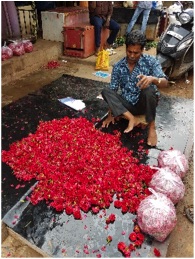

Flower Markets

The marriage of Meenakshi and Shiva was the biggest event, with all gods, goddesses and living beings gathered. Vishnu gives her away to Shiva at the wedding.
Following the tradition, every evening, before closing the temple, a ritual procession led by drummers and a brass ensemble carries the image of Sundareswarar to Meenakshi’s bedroom, and every morning she is brought back to the sanctum.
Then we head to Kanyakumari, the point where 3 oceans meet: Bay of Bengal, Indian Ocean and the Arabian Sea. You’ll see the Vivekananda Rock memorial, the Thiruvallur Statue, and then the perfect viewing point for spectacular sunsets.
Day 7: FRIDAY to Kovalam
Welcome to Kovalam, an internationally renowned beach with three adjacent crescent beaches. A massive rocky promontory on the beach has created a beautiful bay of calm waters ideal for relaxing, sun bathing and swimming.
Days 8 & 9: SATURDAY & SUNDAY Kovalam
There are several beautiful palm-fringed beaches in the area, where you can 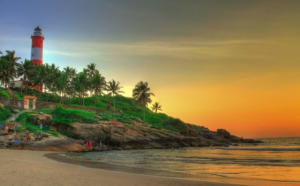 shop, pause for a beer and people watch. Perhaps the most spectacular beach is Lighthouse Beach, where you can climb 140 steps to the 30m tall lighthouse. From there you can see the village of Poovar on one side and Beemapalli Mosque on the other.
shop, pause for a beer and people watch. Perhaps the most spectacular beach is Lighthouse Beach, where you can climb 140 steps to the 30m tall lighthouse. From there you can see the village of Poovar on one side and Beemapalli Mosque on the other.
Kovalam Art Gallery or Sree Chithra Art Gallery displays valuable and significant paintings by famous painters of the Kerala community. Other displays relate to ancient traditions and heritage culture from the Mughal and Rajput eras, as well as artifacts from China, Japan and Tibet.
We’ll visit Halcyon Castle, also known as Napier Museum, for afternoon tea. Built in 1932 as a summer retreat the palace was sold to the Kerala Government in 1964 and has recently been converted into one of South India’s best 5-star luxury hotels.
Day 10: MONDAY to Kumily
This is a tea and spice growing region, also known for wildlife reserves. Our accommodation for the next 2 nights is the Jungle Park Resort where your bedroom windows open onto a vista of the national park. From your balcony, you’ll likely see monkeys and deer grazing on the edge of the forest.
Day 11: TUESDAY Kumiiy (EARLY START)
We visit Periyar National Park a wildlife sanctuary covering over 750 square kilometres and featuring a wide array of habitats in the Cardamom Hills. The sanctuary is an ideal home for mammals, birds and reptiles. We’ll plan for an early morning boat ride on Lake Periyar. Lunch is at the Jungle Park Resort.
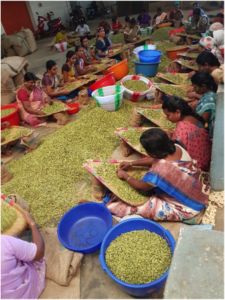 In the afternoon we’ll enjoy visiting the Hill Top Spices Marketing Centre, the Aroma Organic Spice & Ayurveda Garden, the Cardamom Collection Centre and the Coffee, rice and peanuts roasting store.
In the afternoon we’ll enjoy visiting the Hill Top Spices Marketing Centre, the Aroma Organic Spice & Ayurveda Garden, the Cardamom Collection Centre and the Coffee, rice and peanuts roasting store.
Day 12: WEDNESDAY to Munnar. This town in Kerala is in South India’s Western Ghats mountain range and is dotted with tea plantations established in the late 19th century. Relax and enjoy a cooking demonstration at our hotel where we’ll stay for the next 2 nights.
Day 13: THURSDAY Munnar
See Eravikulam National Park. Declared as a Sanctuary in 1975, three years later it was declared a National Park where the endangered Nilgiri Thar (mountain goat) is protected. Spread over 97 sq. km., this park holds the largest viable population of Tahr, several other species of rare animals, birds and butterflies: around 19 species of amphibians, 26 species of animals, and over 132 species of birds.
LUNCH: Eravikulam National Park
Marayoor
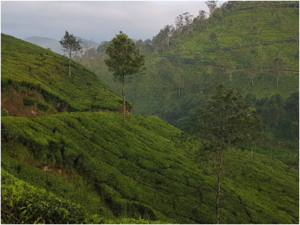 The sandal wood factory of the forest department, the caves (Muniyaras) with murals and relics from the new stone age civilization and the children’s park spread across a hectare of land under the canopy of a single Banyan tree are of great interest. Our last stop will be at the Parvati Tea Plantation.
The sandal wood factory of the forest department, the caves (Muniyaras) with murals and relics from the new stone age civilization and the children’s park spread across a hectare of land under the canopy of a single Banyan tree are of great interest. Our last stop will be at the Parvati Tea Plantation.
Day 14: FRIDAY Munnar
We start with a Morning walk . Munnar is a hill station and former resort for the British Raj elite, so there are many interesting sights.
Travel to Thanneermukkom (The Backwaters)
Thanneermukkom is on the banks of Lake Vembanad, which has a salt water barrier across the lake dividing it into two parts – one with perennially brackish water and the other part fed with fresh water by the rivers draining into the lake. The result is an idyllic network of tranquil canals and lagoons, known as the Kerala backwaters.
Day 15: SATURDAY The Backwaters
The barrier has helped local farmers who farm below sea level. We’ll be cycling country lanes, enjoying Ayurvedic Spa treatments, and a visiting a Yoga room with morning music.
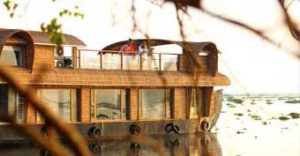 We’ll take a day cruise on a Kettuvallam Houseboat. The name means ‘boat with knots’ because coir ropes tied in knots hold together the entire structure of the boat with not a single nail used! (Includes lunch & beach stop.)
We’ll take a day cruise on a Kettuvallam Houseboat. The name means ‘boat with knots’ because coir ropes tied in knots hold together the entire structure of the boat with not a single nail used! (Includes lunch & beach stop.)
Day 16: SUNDAY Mararikolum (Marari) Beach
 We’ll pass through Alleppey [Alappuzha] on our way to nearby Mararikolum Beach. We’ll be in this area of South India for three days and we’re arriving at the perfect time (after the monsoon) to see the magnificent natural beauty of the waterways (often called the ‘Venice of the East.)
We’ll pass through Alleppey [Alappuzha] on our way to nearby Mararikolum Beach. We’ll be in this area of South India for three days and we’re arriving at the perfect time (after the monsoon) to see the magnificent natural beauty of the waterways (often called the ‘Venice of the East.)
Day 17: MONDAY Mararikolum Beach
Alleppey or Alappuzha is the traditional business hub of Kerala and has a number of tourist attractions and points of interest, especially its old and fascinating architecture. We’ll visit Krishnapuram Palace (age unknown) to see a 49 sq. metre single mural painting, the Gajendra Moksham. One of the most famous explots of Vishnu, it depicts Vishnu coming down to earth to protect Gajendra, the elephant, from the clutches of Makara, the Crocodile.
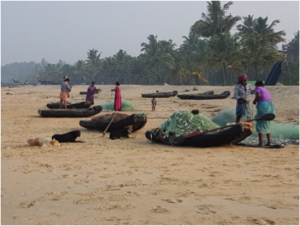 We’ll visit the 137 year old Alleppey pier, sadly in disrepair, and see the 19th-century Alappuzha Lighthouse.
We’ll visit the 137 year old Alleppey pier, sadly in disrepair, and see the 19th-century Alappuzha Lighthouse.
Day 18: TUESDAY Mararikolum Beach
Last day at the beach. Choose to spend it relaxing on the beautiful golden sand or come with us to visit the Mannarshala Temple, one of the few snake temples in Kerala!
Day 19: WEDNESDAY Kochi
Kochi (Fort Cochin) has been South India’s most important trading port for more than 500 years. We’ll tour historic areas with a vast range of influences, including India’s oldest synagogue and Jewish area, the Dutch Fort, and St Francis Church.
We’ll see Kerala Folklore Museum . Privately owned and packed with artifacts, the building itself is a marvel.
Constructed in 1567 on land given by the Raja of Kochi, the Paradesi Synagogue is the oldest active synagogue in the British Commonwealth. The literal meaning of the term Paradesi is “foreigners”, applied to the synagogue because it was built by Sephardic or Spanish-speaking Jews, some of them from families exiled in Aleppo, Safed and other West Asian localities. Dress code is important today, please wear ½ sleeves or similar.
In contrast, we’ll see the Jain Temple, dedicated to the Jain Tirthankar Shri Dharmanath and famous for its architectural excellence.
We’ll visit the SNC Maritime Museum. India is reckoned as one of the top ten naval powers in the world and has a formidable naval force, which plays a crucial role in safeguarding territorial waters of India.
The great maritime heritage of the Indian Navy dates back to Indus Valley civilizations; Kerala’s trade links with Arabs, its famous maritime hero Kunjali Marakkar; influence of India’s maritime power in South East Asia; and colonization of the Indian sub-continent by European powers. In 1612 the Indian Marine was established in Surat.
Originally built in 1503, St Francis Church is the oldest European church in India. The Portuguese explorer Vasco da Gama died in Kochi in 1524 when he was on his third visit to India. His body was originally buried in this church, but after fourteen years his remains were removed to Lisbon.
The Franciscans had control over the church until the Dutch captured Kochi in 1663. While the Portuguese were Roman Catholics, the Dutch were Protestants and they demolished all the churches except this one. They reconditioned it and converted it into a government church.
In 1795, the British captured Kochi from the Dutch but allowed the Dutch protestants to retain the church. In 1804, the Dutch handed over the church to the Anglican Communion who likely changed the name of the patron saint to St. Francis. It was placed under the Ecclesiastical Department of the Government of India.
We’ll see the Chinese Fishing Nets at Fort Kochi Beach. The “lifting nets” are an ingenious fishing technique allowing a single fisherman to operate a 20-metre-wide fishing net, unaided.
We’ll visit Kerala’s Cultural Arts Village an art gallery restaurant, curio shop and book shop featuring vignettes of Kerala’s cottage and craft industry.
Day 20: THURSDAY Kochi
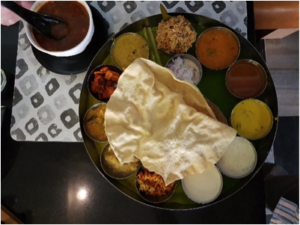 Time to do some serious last-minute shopping, with the Marine Drive Walkway and Shopping area right outside our hotel.
Time to do some serious last-minute shopping, with the Marine Drive Walkway and Shopping area right outside our hotel.
And there’s a learning experience in store for you, as we enjoy participating in the preparation of a traditional Hindu “Sadhya” served on a banana leaf. Find out about the traditions and history behind the dishes.
Day 21: FRIDAY 30th November Farewells and leave for Kochi airport
